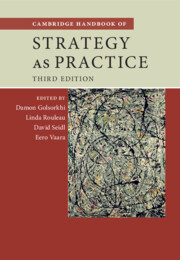Book contents
- Cambridge Handbook of Strategy as Practice
- Cambridge Handbook of Strategy as Practice
- Copyright page
- Contents
- Figures
- Tables
- Boxes
- Contributors
- Preface to the Third Edition
- Introduction: What Is Strategy as Practice?
- Part I Ontological and Epistemological Questions
- Part II Theoretical Resources: Social Theory
- Part III Theoretical Resources: Organization and Management Theories
- Part IV Methodological Resources
- Part V Substantive Topic Areas
- Chapter 33 Strategic Planning as Practice
- Chapter 34 Meetings and Workshops as Strategy Practices
- Chapter 35 The Role of Materiality in the Practice of Strategy Revisited
- Chapter 36 Participation in Strategy Work
- Chapter 37 Open Strategy as a New Form of Strategizing
- Chapter 38 The Role of Emotions in Strategizing
- Chapter 39 Temporality in Strategy as Practice
- Chapter 40 Multimodality in Strategy-as-Practice Research
- Chapter 41 The Role of Play in Strategizing
- Chapter 42 Feminist Perspectives on Doing Strategy-as-Practice Research
- Chapter 43 At the Interface of Extreme Contexts and Strategy as Practice
- Index
- References
Chapter 40 - Multimodality in Strategy-as-Practice Research
from Part V - Substantive Topic Areas
Published online by Cambridge University Press: 11 March 2025
- Cambridge Handbook of Strategy as Practice
- Cambridge Handbook of Strategy as Practice
- Copyright page
- Contents
- Figures
- Tables
- Boxes
- Contributors
- Preface to the Third Edition
- Introduction: What Is Strategy as Practice?
- Part I Ontological and Epistemological Questions
- Part II Theoretical Resources: Social Theory
- Part III Theoretical Resources: Organization and Management Theories
- Part IV Methodological Resources
- Part V Substantive Topic Areas
- Chapter 33 Strategic Planning as Practice
- Chapter 34 Meetings and Workshops as Strategy Practices
- Chapter 35 The Role of Materiality in the Practice of Strategy Revisited
- Chapter 36 Participation in Strategy Work
- Chapter 37 Open Strategy as a New Form of Strategizing
- Chapter 38 The Role of Emotions in Strategizing
- Chapter 39 Temporality in Strategy as Practice
- Chapter 40 Multimodality in Strategy-as-Practice Research
- Chapter 41 The Role of Play in Strategizing
- Chapter 42 Feminist Perspectives on Doing Strategy-as-Practice Research
- Chapter 43 At the Interface of Extreme Contexts and Strategy as Practice
- Index
- References
Summary
Eric Knight and Matthias Wenzel examine the multimodality of strategizing. Drawing parallels to research in other domains of organization studies, they show that the enactment of strategic practices involves, amongst others, discursive modes (i.e., written or oral texts such as speech acts, emails, documents or newspaper articles), bodily modes (i.e., bodily movements such as gestures, gazes, nodding or pointing) and material modes (i.e., objects and artefacts such as tables, chairs, rooms or tools). As the concept of multimodality signals, these different modes are typically interrelated. That is, one typically finds a constellation of different modes involved in strategy work. The authors review existing strategy as practice research in terms of how they have conceptualized and captured the multimodality of strategy work. They distinguish three different conceptualizations, which they label ‘multimodality as representation’ (treating different modes as reflected in each other), ‘multimodality as co-creation’ (treating different modes as recursively shaping each other) and ‘multimodality as intertwinement’ (treating different modes as amalgamated). They discuss how each view of multimodality allows for different types of insights to be gained on the doing of strategy.
Keywords
- Type
- Chapter
- Information
- Cambridge Handbook of Strategy as Practice , pp. 729 - 739Publisher: Cambridge University PressPrint publication year: 2025

